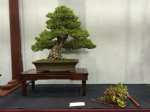Bolero
Omono
Assuming we already have a Good Bonsai Tree...We now want to Morph the Bonsai into a Work of Art....
Therefor IMO we need to address the Ceramic Pot and the Ground Cover...
The Pot has to be the right Color, the right Size & the right Configuration...Size is VIP, not too big, not too small, Complimenting the Tree not Overwhelming or Underwhelming the Tree...
The right Ground Cover can Make or Break an Artful Presentation and should Represent the Natural Ground Cover of the Tree, Rocks can offer an additional feature to the GC if the Context requires...
All of the above is, of course, subject to ones perception, however, still somewhat resembling the original GC of the Tree....
Comments and pictures welcomed...
Therefor IMO we need to address the Ceramic Pot and the Ground Cover...
The Pot has to be the right Color, the right Size & the right Configuration...Size is VIP, not too big, not too small, Complimenting the Tree not Overwhelming or Underwhelming the Tree...
The right Ground Cover can Make or Break an Artful Presentation and should Represent the Natural Ground Cover of the Tree, Rocks can offer an additional feature to the GC if the Context requires...
All of the above is, of course, subject to ones perception, however, still somewhat resembling the original GC of the Tree....
Comments and pictures welcomed...









